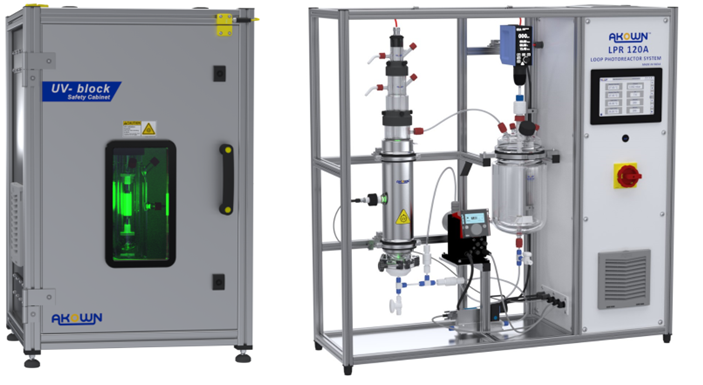Photo Chemical Reactors (Lab Scale)

Our lab-scale photochemical reactor is designed for rapid and efficient evaluation of light-driven chemical processes. Ideal for feasibility studies, this compact system supports a wide range of wavelengths (UV to visible) and offers precise control over temperature, light intensity, and reaction conditions. Suitable for batch or continuous-flow operation, it’s perfect for screening photocatalysts, optimizing reaction parameters, and scaling up photochemical processes.
A compact spectrometer integrated with a photochemical reactor enables real-time measurement of light absorption by reactants, products, or catalysts helping researchers fine-tune reaction conditions .
Light Not Heat or how well-thought-out system can be used for photochemistry in R&D and Production

In synthesis, photochemistry is the method of choice. UV light can vastly speed up many chemical syntheses – or make them possible in the first place. Unlike with thermal excitation, light-induced reactions frequently take place at room temperature and are therefore less destructive. Sensitive molecules remain intact and there are fewer by- products.
Our custom-built lab-scale photochemical reactors are designed to meet the unique needs of your research. Whether you’re working in organic synthesis, environmental testing, or photocatalysis, we offer tailored solutions that integrate precise light control, temperature regulation, and modular reactor design. Choose from batch, flow, annular, or slurry configurations with support for UV, visible, or solar-simulated light sources.
Furthermore, we offer the possibility to analyse the reactor geometry of planned or existing production scale photoreactors utilizing professional flow-simulation along with physical radiation data to optimise photo-chemical processes.
Comparison of Light Sources for Photochemical Reactions
| Feature | UV LED | Low Pressure Mercury Lamp | Medium Pressure Mercury Lamp | High Pressure Mercury Lamp | Xenon Arc Lamp |
|---|---|---|---|---|---|
| Spectrum | Narrow, single wavelength (e.g. 365, 385, 395, 405, 420, 460, 525, 592, 625 nm) | Very narrow (mainly 254 nm) | Discrete peaks (254, 313, 365 nm) | Broad UV-visible peaks | Continuous broad (UV–Vis–NIR, ~200–1000+ nm) |
| UV Output | Moderate to high (targeted) | High at 254 nm | High in 200–400 nm | Moderate to high | High (less UV-specific) |
| Intensity | Highly focused, tunable | Low to moderate | Moderate | High | Very high |
| Heat Generation | Low | Very low | Moderate | High | Very high |
| Application Fit | Precise control, modular setups, catalyst screening | Germicidal, disinfection, simple UV reactions | UV-specific reactions & photocatalysis | Broad-spectrum, high-energy photochemistry | Solar simulation, photostability, broad reactions |
| Wavelength Control | Very precise | Fixed (254 nm) | Discrete peaks | Broad peaks | Requires filters |
| Lifespan | Long (~10,000–20,000 hrs) | Long (~8,000–10,000 hrs) | ~1,000–2,000 hrs | ~2,000–5,000 hrs | ~500–1,500 hrs |
| Typical Spectral Graph | 📈 Narrow spike at set λ (e.g. 365 nm) | 📈 Sharp peak at 254 nm only | 📈 Multiple sharp UV peaks | 📈 Broad peaks across UV and visible | 📉 Smooth continuous curve (UV–NIR) |

